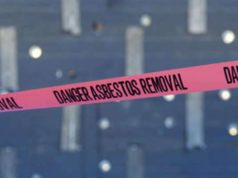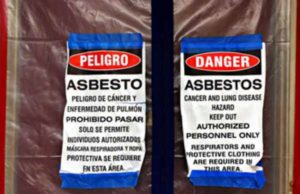 Asbestos is a set of six silicate minerals which are used commercially for their physical properties. Asbestos contains thin fibrous crystals that, when inhaled, can cause serious illness to the lungs in the form of malignant lung cancer or mesothelioma, which precipitates a complete breakdown of the respiratory system. Long term exposure to asbestos in high concentrations can spark such health problems.
Asbestos is a set of six silicate minerals which are used commercially for their physical properties. Asbestos contains thin fibrous crystals that, when inhaled, can cause serious illness to the lungs in the form of malignant lung cancer or mesothelioma, which precipitates a complete breakdown of the respiratory system. Long term exposure to asbestos in high concentrations can spark such health problems.
As a result of the inherent dangers associated with the mineral, the European Union has banned all use of asbestos. In the United States, however, asbestos-based materials are still found in older buildings or structures. To prevent the development of mesothelioma or cancerous diseases associated with the inhalation of asbestos, numerous laws and regulations have been enacted in regards to the construction procedures of asbestos.
Types of Asbestos
As defined by the United States Environmental Protection Agency, there are six minerals which are defined as “asbestos”-based materials. All forms of asbestos belong to the serpentine class chrysotile, which belongs to the amphibole class amosite, corcidolite, tremolite, actinolite, and anthophyllitye. The distinctions between serpentine and amphibole-based asbestos are found in their chemical compositions and their degree of potency when inhaled by human beings.
Asbestos Usage
Asbestos-based materials or products have long been used in the construction of both commercial and private structures. During the Industrial Revolution, the development of commercial asbestos became prevalent for its relatively cheap cost. Asbestos products or materials were used in a number of structures and for a number of reasons including: fire retardant coatings, pipes and fireplace cement, heat, acid resistant gaskets, pipe insulation, ceiling insulation, fireproof drywall, lawn furniture, dry wall, and other forms of insulation.
The multitude of uses stems from the mineral’s inherent characteristics.
Asbestos is effective at insulating materials and covering other materials to provide protection from fire or excessive heat. Asbestos products contain special qualities that aid in insulation, fire protection, and strengthening other materials.
Health Problems Related with Asbestos Use
Medical research has revealed that chronic or excessive exposure to inhaled asbestos flakes can be hazardous to an individual’s health. The risks associated with asbestos are generally related to constant exposure during the handling of asbestos fibers in construction or work environments. When inhaled, the asbestos fibers stick to the outer linings of the lungs. The fibers then attack the mucus walls and the trachea. The fibers, in essence, stick to the individuals lungs and infiltrate the respiratory system’s natural process. Over time, these crystalized agents manipulate and alter the cell’s structure. When altered, the cells can become cancerous and spread throughout the body.
Asbestos Today
As a result of the deaths and hazards associated with the inhalation of asbestos, many states have instituted laws which ban or regulate the use of asbestos in commercial or private structures. Although asbestos is still used today, all materials that contain the minerals are enclosed in a protective casing. This casing will prevent the asbestos flakes from chipping away and subsequently travelling into open spaces. To further regulate asbestos use, whenever a building is renovated or demolished, an asbestos survey must be conducted to reveal any materials that contain the mineral. If the survey reveals traces of asbestos, an abatement procedure will be administered to remove all forms of the hazardous material.





























